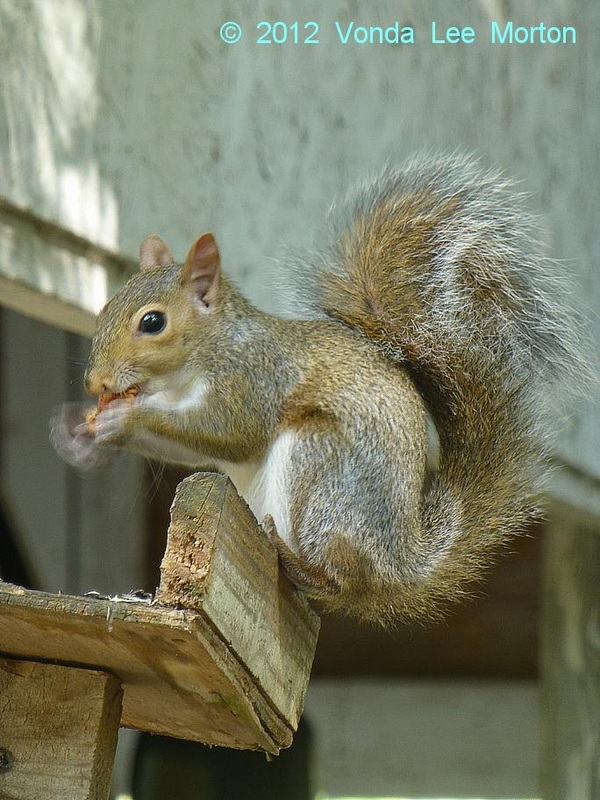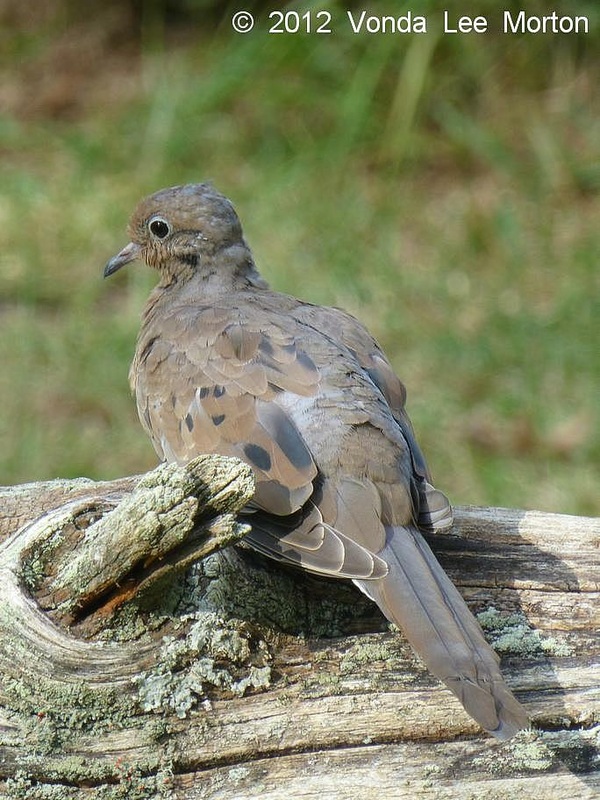The last of the gray squirrels is officially gone—he’s not coming around for handouts now, but I did catch him at one of the feeders last week and snapped a photo for your viewing pleasure.
|
I’ll be dropping back to two updates a month—around the first and the fifteenth—for the remainder of the year, unless I have an unusually heavy week of intakes or an especially interesting or rant-inducing intake. The last of the gray squirrels is officially gone—he’s not coming around for handouts now, but I did catch him at one of the feeders last week and snapped a photo for your viewing pleasure. The doves have been released; I still see the mourning doves on the fence every now and then, but the Eurasian collared dove has totally flown the coop, no pun intended. The flyers continue to grow and are becoming shyer and less willing to come out of their little nest to be fed; I’m putting the syringe at the opening and letting them pop their heads out to eat. And, of course, they’re getting a wider variety of solid foods each week, including the occasional pecan treat! The one intake for the past two weeks was a DOA juvenile peregrine falcon. The finder and the transporter both said the bird, who was unable to fly, was active and aggressive when captured and during the ride to me, but when I opened the box to examine it, it was dead. Apparently it had died fairly recently during the trip, as it was still warm and rigor hadn’t set in. A post-mortem exam showed no broken bones, no puncture wounds—not a feather out of place. Given that his beak was full of fresh, dark blood, my guess is that he was a victim of rodenticide poisoning and the thrashing the transporter heard in the box was the seizures of a dying bird. No necropsy will be performed, since rehabbers in Georgia do not have ready access to necropsies; the one university in the state that performs them charges both us and DNR for them. DNR has faced budget cuts in recent years, and as you all know by now, rehabbers pay our operating costs out of our own pockets and the few donations we receive in any given year. This means that too often we’re left making educated guesses as to the cause of death, but necropsies aren’t cheap, and those funds can be better put to use on saving other critters under our care. Sad to say, it comes down to a matter of priorities—do we spend the money on a necropsy to confirm our guess as to cause of death, or do we use that money on resources needed for our living intakes? I can’t help the dead; I can help the living. Yeah, I know that sounds harsh—welcome to the world of wildlife rehab.
6 Comments
Well, technically, the new critters all came in last month, but hey, that doesn’t make for an interesting header, now does it? The gray squirrels that were slated for return to their finders instead found the “escape hatch” on their pre-release pen, which I had neglected to latch properly out of habit—it’s to allow squirrels the opportunity to come and go as they please until they “don’t please” to come back anymore. These two are untouchable now and very seldom visiting their pen these days. It’s actually best for the squirrels, though, honestly, as this is the area they now view as their home territory. Another gray squirrel came in last week; the finder thought he was a fox squirrel because of his reddish tint. The squirrel was old enough to be on his own but was very lethargic and docile. I started him on fluids and meds, but he didn’t make it through the afternoon. This fledgling dove was luckier. She was found wandering around a back porch in a neighborhood of free-roaming cats. The general rule of thumb with uninjured fledgling birds is to leave them alone and allow their parents to continue to care for them, but in cases where the bird’s life is in danger, it’s best to remove the fledgling from the potentially life-threatening situation. This baby was pretty close to independence, so she’s in the flight pen with the other doves, and they should all have flown the coop by the end of the week. As an example of what happens when cats are allowed to roam freely, take a look at this poor female summer tanager. She was found wandering the sidewalk in a town a few counties away on Sunday the 30th , and when the finder brought her to me, I knew with one glance that she was the victim of a cat attack. The cat had punctured the tanager’s head right at the beak, and the right wing had a nasty open fracture. She died during the night. Soapbox time: People, domestic cats belong INDOORS! If you absolutely must allow your cat outside, there are cat runs that will protect our native wildlife while safely giving the cat a taste of the great outdoors. Check any pet supply website, catalog or store; I’m sure you’ll find numerous variations on these safety enclosures, and many of them are portable. A second flying squirrel came in last week; he was found on the porch by a husband headed to work in the early AM, and his wife brought the little fellow to me. He’d fallen from somewhere hard enough to bloody his nose, his jaw was a bit swollen, and his left front leg was bruised and swollen but not broken. I started him on meds, and he’s doing just fine now. He and the older flyer are in the same cage and share layers of the same blanket but otherwise ignore each other. The older flyer is more active at night now and is eating solids, but will remain on formula feedings for a while yet, as well. Flyers mature a bit more slowly and tend to stay with their mothers longer than gray squirrels: fall babies often overwinter in the nest with their mothers.
|
Archives
April 2023
Categories
All
|



















 RSS Feed
RSS Feed
